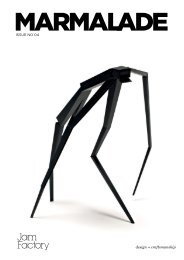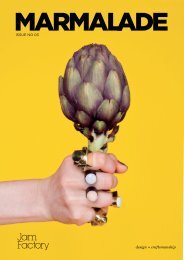Marmalade Issue 5, 2017
Create successful ePaper yourself
Turn your PDF publications into a flip-book with our unique Google optimized e-Paper software.
In Australia, it was in the aftermath of the Second World<br />
War that all the components of what we think of as the<br />
modern Crafts Movement appeared and ceramics was at<br />
the forefront of this new approach to a very old craft. Small<br />
workshops flourished, courses began to appear and ceramics<br />
began to be seen in mainstream art galleries, often as the<br />
accompaniment to an exhibition of paintings but sometimes<br />
as the major feature, as in the ground-breaking work made<br />
by David and Hermia Boyd who had sell-out shows and<br />
achieved great notoriety through the exhibitions of their<br />
ceramics in the 1950s.<br />
This pattern increased throughout the 1960s (which<br />
interestingly was also a period of social change) and by the<br />
early seventies ceramics, and the Crafts in general, played a<br />
prominent part in Australian cultural life.<br />
Governments became increasingly involved in arts funding,<br />
with a dedicated federal crafts-funding body and state-based<br />
boards, and ceramics was a significant beneficiary of this<br />
largesse. Ceramics courses proliferated within art schools,<br />
TAFE and other adult education courses, ceramics was<br />
taught in schools and numerous practitioners established<br />
successful careers built on the back of a wide public interest<br />
in the field. This was the climate which allowed for the birth of<br />
JamFactory, a visionary organisation which can truly claim to<br />
be ‘innovative’ and is a model which has yet to be reproduced<br />
in this country, let alone bettered.<br />
Nonetheless, it’s true to say that throughout the eighties<br />
and nineties, away from nurturing environments such as<br />
that provided by JamFactory, something happened, and the<br />
interest in ceramics waned. Perhaps it was the extraordinary<br />
growth of digital technologies and a strong bias towards<br />
conceptualism in the art world (and particularly in art<br />
education) that made the manipulation of mud, no matter<br />
how skilful, seem somehow redundant, too ‘old school’.<br />
Institutions like JamFactory with its long commitment to<br />
ceramics, persisted, but there was a diminishment of teaching<br />
within the tertiary sector and Australia-wide the penetration<br />
of hand-crafted ceramics in the broader public sphere<br />
was lessened.<br />
It’s always hard to judge these things accurately, but in the<br />
late nineties and into the 2000s ceramics began to gather<br />
strength again: the impetus was coming from somewhere,<br />
but the question was where?<br />
My observation is that the trend towards ceramics’ newfound<br />
popularity had several points of reference and that<br />
these were fortuitously coincidental.<br />
One explanation was the unprecedented rise to fame of<br />
the Australian ceramic artist (I’m sure she would have been<br />
happier being called a potter), Gwyn Hanssen Pigott in the<br />
1980s. After a long career in both England and Australia as<br />
a maker of lovely, but rather underappreciated domestic<br />
wares, Hanssen Pigott created what amounted to a new way<br />
of looking at ceramics – a ‘still life’. At once the objects and<br />
their depiction, packaged in an exquisite, seemingly simple<br />
moment – they took the art world by storm. Hanssen Pigott<br />
became properly famous and her elevation of the humble,<br />
well-crafted, beautifully-realised pot provided a muchneeded<br />
shot in the arm for ceramics, proof that success was<br />
32 / ISSUE 05











